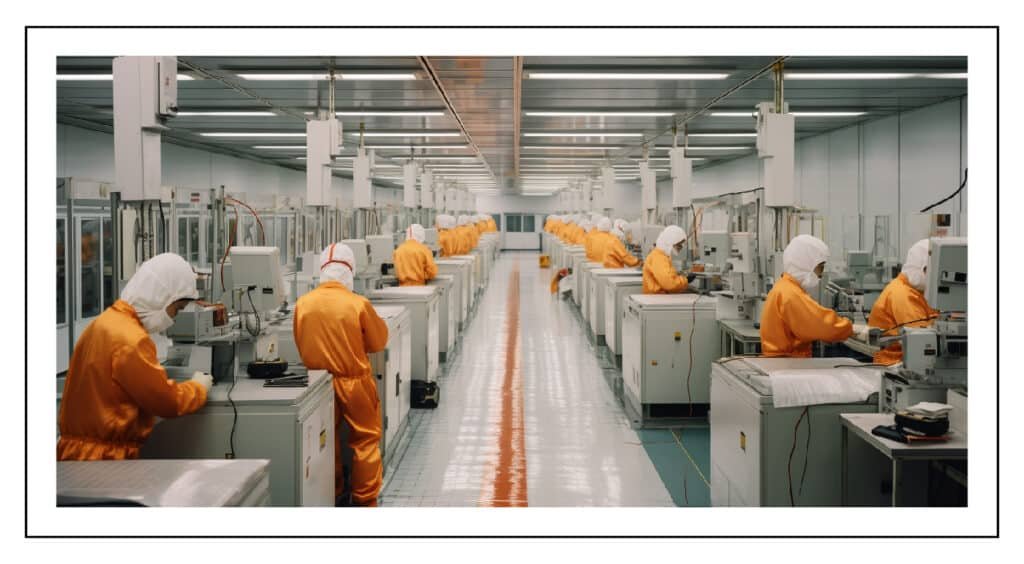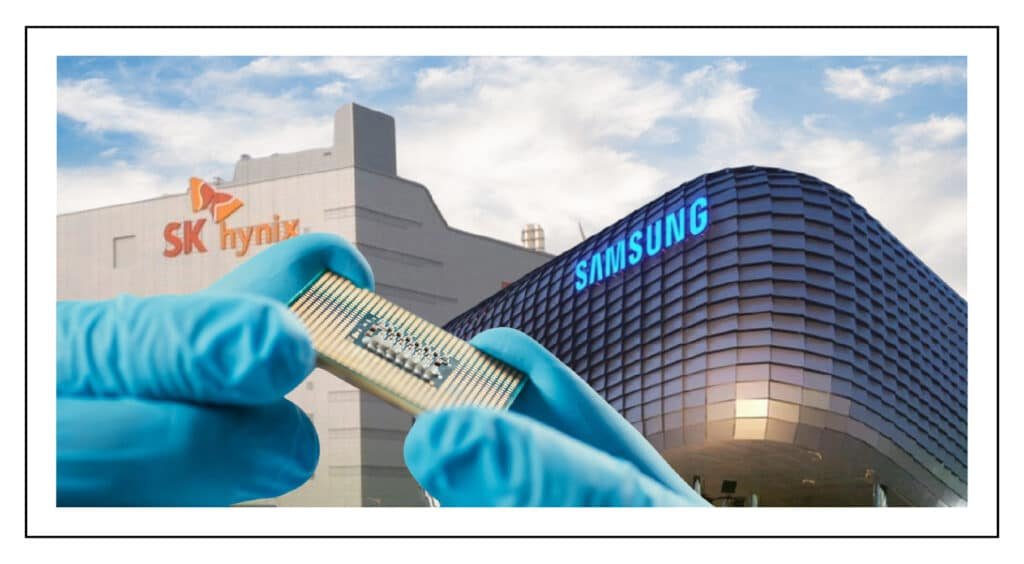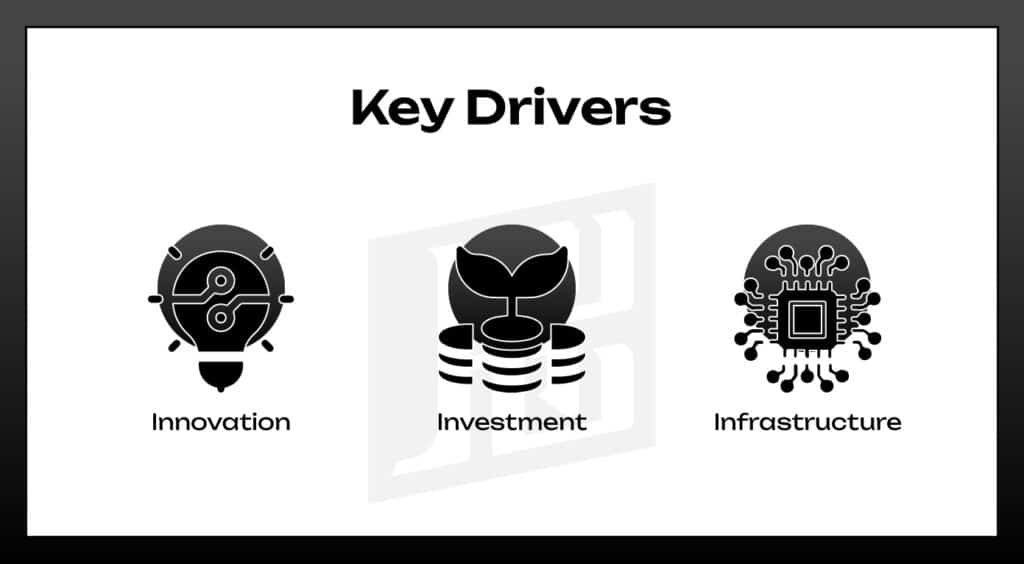The Surge of South Korea’s Semiconductor Industry: Opportunities and Innovations

South Korea’s Incredible Rise in the Semiconductor Industry

South Korea, known for its heritage, has earned recognition for its remarkable technological advancements. It is celebrated for its traditions and has established itself as a semiconductor industry pioneer. So, what are the key factors that have contributed to this journey? Let’s explore the story behind it.
Historical Background: From Humble Beginnings to Global Influence

In the 1970s, South Korea embarked on its journey in the semiconductor industry with goals. Initially focusing on component assembly, they received support from the government, which nurtured electronic companies.
The 1980s played a role in shaping the industry’s growth trajectory. Backed by government initiatives and a strong emphasis on technology-centered education, leading companies like Samsung embarked on groundbreaking ventures in DRAM production, igniting South Korea’s success story in semiconductors.
From the 1990s to the 2000s, South Korea witnessed an ascent to prominence in semiconductors. By embracing cutting-edge chip technologies and prioritizing research and development efforts while fostering collaborations between institutions and industry players, significant advancements were made – including breakthroughs like High k Metal Gate technology.
In the year (2023) South Korea’s dominance in semiconductors is undeniable. The nation influences sectors such as DRAM and NAND flash memory production.
Moreover, Korean semiconductor companies are well-positioned to shape the future of technology by embracing emerging fields such as AI (Artificial Intelligence) and IoT (Internet of Things)—Quantum computing.
The Driving Factors: Innovation, Investment, and Infrastructure

Regarding innovation, Korea’s industrial sectors demonstrate their spirit through collaborations between universities like KAIST and POSTECH with industry giants. These partnerships have led to groundbreaking advancements in chip technologies like 7nm and 5nm.
Commitments from both the private sectors strongly support Korea’s semiconductor ambitions. The government’s “Semiconductor Vision 2020” showcases a vision for sector growth with funds allocated for its advancement.
Infrastructure plays a role in Korea’s success story. For instance, Samsung’s Hwaseong Campus is a testament to its achievements in infrastructure. It houses cutting-edge fabs, follows quality control measures, and boasts logistics systems – all contributing to positioning Korea as a prominent semiconductor hub.
However, it is essential to note that the global acclaim of South Korea’s semiconductor industry goes beyond prowess. It is also a result of vision, leadership, and an ecosystem that extends beyond industry giants.
Enterprises Role: Contributions Beyond Major Players

While big names like Samsung and SK Hynix often grab the headlines, it’s essential to recognize the story behind Korea’s success in the semiconductor industry.
Although Samsung and SK Hynix are known players in the semiconductor sector, it is crucial to acknowledge the ecosystem beyond them. Companies like Inquivix Technologies and TSMC also distribute cutting-edge semiconductor components and provide solutions that cater to market demands. Furthermore, startups bring dynamism to this field with support from government grants and a favorable business environment.
Samsung
The journey of Samsung in the semiconductor arena exemplifies South Korea’s ascent. The company embarked on its semiconductor journey in the 1970s. What truly distinguished Samsung was its thinking vision, manifested through investments in research and development and an unwavering commitment to innovation. By the 1980s, Samsung achieved a technological breakthrough by successfully developing a 256K DRAM. Throughout the decades, Samsung has consistently led advancements in memory chips, contributing to the semiconductor value chain. Their dedication to staying on trends is evident through their ventures into areas such as System LSI and Foundry operations.
SK Hynix
SK Hynix, a player in Korea’s semiconductor industry, has achieved success by identifying market potential and efficiently allocating resources. Starting as Hyundai Electronics, SK Hynix has strategically pursued mergers and acquisitions while prioritizing research and development (R&D). Today, they testify to Korea’s ability to adapt to market shifts, excelling in DRAM and NAND flash memory sectors.
In addition to these industry giants, a multitude of enterprises have contributed significantly to Korea’s dominance in semiconductors. Distributors, equipment suppliers, and design firms ensure operations and optimize supply chains. While companies like DB HiTek and Silicon Works may only grab headlines occasionally, their specialized expertise in areas such as analog semiconductors and IC design services is vital to the overall industry.
The interconnected relationship between these players and more minor contributors forms the foundation of Korea’s semiconductor achievements.
The Korean semiconductor industry offers an ecosystem that fosters collaboration and competition, leading to agility, resilience, and innovation. This not only positions Korea as a competitor but also sets high standards.
Exploring Opportunities in the Korean Semiconductor Landscape for Global Brands

South Korea’s semiconductor industry blends heritage and cutting-edge innovation, providing an opportunity for global brands. The country’s journey from being an electronics assembler to becoming a player in the worldwide semiconductor market provides valuable lessons and promising collaborative prospects.
One of the attractions of the semiconductor landscape is its comprehensive approach to growth. While chip manufacturing receives attention, the industry thrives on world-class research and development facilities, thriving startups specializing in niche innovations, and strong government support through policies and funding. Although Samsung and SK Hynix stand as pillars, a community of suppliers, designers, and researchers drives progress in the field.
For brands seeking entry into this landscape, there are avenues to explore. Some examples are collaborative research and development initiatives, partnerships in chip design, or manufacturing ventures venturing into emerging fields like green chips or quantum semiconductors. However, achieving success within this landscape requires a nuanced understanding. Understanding the customs of businesses, the regulations in place, and building partnerships can be crucial.
To tap into the potential of Korea’s semiconductor industry, aligning with its values of innovation, resilience, and collaboration is essential. For brands to embark on this journey, entering the Korean semiconductor sector offers growth and an opportunity to shape the future of technology.
Key Drivers: Innovation, Investment, and Infrastructure

The factors driving South Korea’s success in the semiconductor industry result from efforts encompassing innovation, investment, and infrastructure. South Korea’s progress in this field is not a coincidence. An approach to innovation, strategic investments, and state-of-the-art infrastructure drives it. The semiconductor industry in South Korea thrives due to leadership and an ecosystem that extends beyond the industry giants.
Innovation
South Korea’s achievements in semiconductors stem from their dedication to innovation. Academic institutions and research organizations in South Korea have consistently fostered collaborations with the industry, leading to groundbreaking research and progressive advancements.
Leading Korean universities like KAIST and POSTECH have partnered with industry leaders to achieve milestones in chip technologies, such as 7nm and 5nm technologies. Despite facing challenges in territories, South Korea has consistently showcased its commitment to innovation through advancements in DRAM technologies. The introduction of 3D NAND structures.
Investments in research and development support this commitment, positioning South Korea as one of the leaders in semiconductor technologies.
Investment
Recognizing the importance of having resources to turn vision into reality, the Korean government, in collaboration with entities, has made significant investments in the semiconductor sector. The government has supported the industry by funding grants, tax incentives, and policies encouraging investments.
In addition, major players in the industry, like Samsung, have committed billions of dollars to establish state-of-the-art fabrication units and drive research forward. These financial commitments did not enhance capabilities. Also, demonstrate Korea’s long-term dedication and unwavering confidence in the semiconductor industry.
Infrastructure
While innovation and investment are crucial, South Korea’s infrastructure truly enables semiconductor dreams to come true. The country is home to some semiconductor fabrication plants (fabs) worldwide. These facilities, including Samsung’s Hwaseong Campus and SK Hynix Icheon production hub, combine cutting-edge machinery with quality control standards.
Moreover, these fabs’ significance extends beyond their scale. As semiconductor nodes continue to shrink in size and quantum computing gains prominence, being adaptable and visionary in response to these advancements will be essential.
The shortage of chips worldwide highlights how much we rely on semiconductors, emphasizing their importance in today’s technology-driven era. South Korea has a growing market for high-quality chips with a history of innovation that positions it to excel in next-generation chip technologies like quantum computing and sustainable manufacturing processes.
As global dynamics continue to evolve, South Korea’s reputation as a partner puts it in a position to form new alliances and trade partnerships, further strengthening its leadership in the industry.
Despite the challenges, the future looks promising for South Korea’s semiconductor industry. It does not lead the way. Also symbolizes innovation and resilience on the global technology stage.
Challenges & Prospects: What Lies Ahead?

Like any leading industry, the semiconductor sector in South Korea faces its share of challenges. Balancing at the top of the semiconductor hierarchy involves managing supply chains, adapting to changing geopolitical landscapes, and staying ahead in an ever-evolving technological landscape.
Challenges
One of the challenges is the chip shortage, worsened by the COVID-19 pandemic and increased demand for technology. This situation has highlighted the importance of diversifying supply chains and reducing dependence on a source. Additionally, there is competition from neighboring countries such as China, which heavily invest in their domestic semiconductor industries and pose threats to market share. Furthermore, there is a race for advancement. As semiconductor nodes continue to shrink and quantum computing gains momentum, keeping up with these developments will require agility and foresight.
Opportunities and Silver Lining
However, every challenge brings forth opportunities. The global chip shortage serves as a reminder of the world’s reliance on semiconductors, reaffirming the industry’s significance in today’s tech-driven era. For South Korea, this translates into an expanding market that eagerly awaits its high-quality chips. Moreover, thanks to its history of innovation, the country is well-positioned to lead in next-generation chip technologies. Whether it be exploring quantum realms or adopting chip manufacturing processes.
Moreover, with changing dynamics, South Korea’s credibility as an ally offers opportunities to establish fresh alliances and trade partnerships, thereby solidifying its dominant position of leadership.
Despite the hurdles, South Korea’s semiconductor sector can still look forward to the future. It does not lead the industry. Also serves as a symbol of innovation and adaptability in the ever-evolving global tech arena.
Discovering Koreas Semiconductor Landscape: Embark on a Journey with Joon K Lee

The story of Korea’s semiconductor industry is a mix of foresight, determination, and ingenuity. As this sector continues to advance, effectively managing its intricacies requires leadership. Collaboration plays a role for brands and individuals eager to capitalize on the opportunities presented by Korea’s semiconductor landscape. Joon K Lee serves as the bridge between expertise and global perspectives. Are you prepared to navigate the frontier of Korea’s semiconductor industry? Get in touch with Joon K Lee. Your trusted partner on this thrilling journey. Click Here
